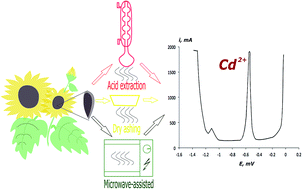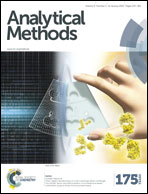Sample preparation for cadmium quantification in sunflower (Heliánthus ánnuus) seeds using anodic stripping voltammetry†
Abstract
The performance of acid extraction, dry ashing, and microwave digestion was evaluated for voltammetric cadmium quantification in oil crops with sunflower (Heliánthus ánnuus) seeds as an example. Standard additions, reference material analysis, and comparison to graphite furnace atomic absorption spectrometry were employed for validation. The main aim of the study was to address the difficulties of oil crop mineralization such as high fat content, material inhomogeneity, and complications in maintaining sample representativeness. 6 brands of fried sunflower seeds (Krasnodar region, Russia) were studied. Acid extraction with nitric acid and hydrogen peroxide provided low digestion efficacy, while dry ashing provided efficient sample decomposition, however, resulted in considerable time frame extension. Microwave-assisted digestion provided the best performance with a dynamic range of 0.05–0.75 μg g−1, detection limit of 0.02 μg g−1, spike recoveries of 95–100%, and within-run relative standard deviation of 5–7%, when using anodic striping voltammetry for Cd quantification.



 Please wait while we load your content...
Please wait while we load your content...